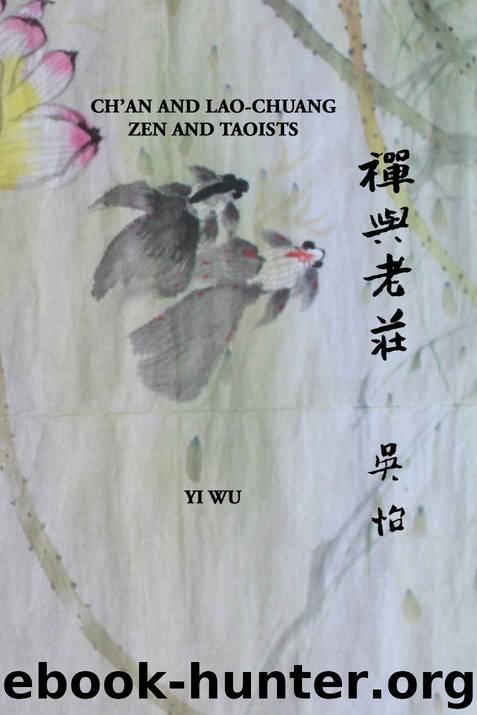Ch'an and Lao-Chuang by Wu Dr Yi

Author:Wu, Dr Yi [Wu, Dr Yi]
Language: eng
Format: epub
Publisher: Unknown
Published: 2012-08-26T16:00:00+00:00
(3) The Spray of Breaking Waves Going Everywhere
Indeed after Ma-tsu and Shih-tou, Chinese Buddhism went through a period of danger in China that was evidenced by the persecution of Hui-ch'ang of Tang Dynasty. There were another three persecutions in Chinese history, which were that of the Emperor Tai-wu of North Wei, the Emperor Wu of North Chou, and Shih-chung of Later Chou. This time of persecution was because of Wu-chung of the Tang Dynasty, who forced monks and nuns to return to a worldly society of only 260,000 people. It was inconsequential if compared to Emperor Wu of North Chou, when at that time there was the persecution of almost three million monks and nuns. But at this time, persecution was not the only problematic factor between the Buddhist and Taoist Religion. There was also a significant movement in China towards a heightened Chinese cultural exclusivity. At that time, beside Buddhism, the religions of Zoroastrianism, Islam, and Nestorianism were also expelled.
In this movement from being anti-foreign to being against Buddhism, Buddhism was really destroyed; not only temples, monks, and nuns, but the thought and system of Buddhism, which was not accepted by Chinese culture. Because of this persecution, the flourishing of Buddhism from the middle of the Tang Dynasty came to gradually decay. It is also very strange that the Ch'an School of Buddhism was not hurt; to the contrary, it developed even further.
There are three reasons that Ch'an School had such ongoing development when other Buddhist schools were decaying:
The first was because Ch'an School did not depend on words, letters, and transmission beyond scriptures; it did not need any
religious form. It could be transmitted by a single individual, so
it was not obstructed by external persecution.
The second reason was because most paths of traditional Buddhism continued to retain consistency with the rules of Indian Buddhism that Buddhist monks and nuns did not work, and continued to depend on begging for a living. Ma-tsu and Pai-chang, who built the system of monasteries and pure rules of the Ch'an School, structured these Schools of Chinese Buddhism so they could be supported by themselves, without being dependent on others. Because of this change Ch'an School could then be free from the difficulty of persecution.
The third reason is that the structural foundation of the Ch'an School was a product of Chinese culture. Their actions of scolding Buddha and the patriarchs of Buddhism and renouncing all sutras can be regarded as a movement of heightened Chinese cultural exclusivity. The only difference is that the movement does not come from the pressure of politics, but from a self-change from within Buddhism. So this time of persecution was not an obstruction to the Ch'an School; instead it actually helped to develop the Ch'an School.
In the above three reasons, the most important is the last one. Since the time of Han Yu, a scholar of the Tang Dynasty who opposed Buddhism and Taoism in order to recover the lineage of Confucianism, all Neo-Confucianists of the Sung Dynasity continued this struggle for the lineage of the Tao.
Download
This site does not store any files on its server. We only index and link to content provided by other sites. Please contact the content providers to delete copyright contents if any and email us, we'll remove relevant links or contents immediately.
| Anthropology | Archaeology |
| Philosophy | Politics & Government |
| Social Sciences | Sociology |
| Women's Studies |
A. A. Milne by Winnie the Pooh Winnie-the-Pooh 02(1279)
The Book of Five Rings by Miyamoto Musashi(1273)
The Bhagavad Gita by Eknath Easwaran(1130)
The Art of War by Sun Tzu(1002)
Bruce Lee Jeet Kune Do by Bruce Lee(904)
The complete book of five rings by Miyamoto Musashi(853)
The Upanishads by Eknath Easwaran(749)
Siddhartha (Penguin Classics Deluxe Edition) by Hermann Hesse(747)
The Four Chinese Classics by David Hinton(725)
The Bhagavad-Gita by Barbara Stoler Miller(722)
Bushido Explained by Alexander Bennett(700)
Roots of Yoga by James Mallinson(692)
Ninja Fighting Techniques by Stephen K. Hayes(679)
Leo Strauss and the Rediscovery of Maimonides by Kenneth Hart Green(678)
The Hundred Tales of Wisdom by Idries Shah(646)
The Yoga Sutras of Patanjali by Patanjali(641)
Chinese Gung Fu by Bruce Lee(636)
Fourteen lessons in Yogi philosophy and Oriental occultism by Yogi Ramacharaka(622)
THE ART OF WAR (Giles Translation) by Sun Tzu(620)
